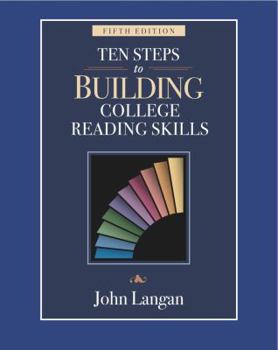Ten Steps to Building College Reading Skills
Select Format
Select Condition 
Book Overview
Features Langan's renowned clear writing style and wide range of writing assignments and activities that reinforce the essentials of good writing including Unity, Support, Coherence, and Sentence... This description may be from another edition of this product.
Format:Paperback
Language:English
ISBN:1591942438
ISBN13:9781591942436
Release Date:January 2011
Publisher:Townsend Pr
Length:612 Pages
Weight:2.05 lbs.
Dimensions:9.0" x 0.8" x 7.3"
Customer Reviews
3 ratings
i got a good deal
Published by Thriftbooks.com User , 16 years ago
i got a good deal and i feel satisfied with the owner because the book still in the good condition..
Reading is fundamental
Published by Thriftbooks.com User , 20 years ago
I use John Langan's `Ten Steps to Building College Reading Skills' as a tutor helping people with limited literacy skills to prepare for community college. Many students who return to school after ten, twenty or more years, having only barely passed high school (or, in some cases, not having passed high school and having obtained a GED instead) find that their basic reading skills have deteriorated - they can read the newspaper or magazine articles somewhat, and can handle various kinds of forms with differing levels of comfort, but the idea of actually reading academic textbooks and working with the information dynamically and analytically is a difficult prospect. Langan's book is useful for a one-semester course or five-to-six month course of one-on-one tutoring. This could also be used in a group setting, and many things in the book are designed to be used in any of these contexts. There are ten primary steps, and ten reading selections in the book. The ten steps are as follows: - Clear thinking - Vocabulary in context - Main ideas - Supporting details - Location of main ideas - Implied main ideas - Relationships - patterns involving addition or involving time - Further Relationships - examples, comparison and contrast, cause and effect - Inferences - Active Reading Each chapter is organised essentially in the same manner. There are sections that are fill-in-the-blank, requiring attentive reading to supply the information; there are explanations and examples of each skills presented, and there are review tests. The review tests (four for each chapter) look at developing comprehension, skills practice, and cumulative skills application. There are also mastery tests that increase in difficulty throughout the text. The tests are tear-out pages, so that they can be handed in for scoring. Each reading selection includes work with vocabulary, reading comprehension, outlining, summarising, and answering discussion questions. This book gives LOTS of practice. The best way for reading to improve is by doing it, and this book provides a wide range of interesting short articles and passages that will highlight particular skills needed for students to succeed in basic college-level reading.
Reading is fundamental...
Published by Thriftbooks.com User , 21 years ago
I use John Langan's `Ten Steps to Building College Reading Skills' as a tutor helping people with limited literacy skills to prepare for community college. Many students who return to school after ten, twenty or more years, having only barely passed high school (or, in some cases, not having passed high school and having obtained a GED instead) find that their basic reading skills have deteriorated - they can read the newspaper or magazine articles somewhat, and can handle various kinds of forms with differing levels of comfort, but the idea of actually reading academic textbooks and working with the information dynamically and analytically is a difficult prospect. Langan's book is useful for a one-semester course or five-to-six month course of one-on-one tutoring. This could also be used in a group setting, and many things in the book are designed to be used in any of these contexts. There are ten primary steps, and ten reading selections in the book. The ten steps are as follows:- Clear thinking- Vocabulary in context- Main ideas- Supporting details- Location of main ideas- Implied main ideas- Relationships - patterns involving addition or involving time- Further Relationships - examples, comparison and contrast, cause and effect- Inferences- Active ReadingEach chapter is organised essentially in the same manner. There are sections that are fill-in-the-blank, requiring attentive reading to supply the information; there are explanations and examples of each skills presented, and there are review tests. The review tests (four for each chapter) look at developing comprehension, skills practice, and cumulative skills application. There are also mastery tests that increase in difficulty throughout the text. The tests are tear-out pages, so that they can be handed in for scoring. Each reading selection includes work with vocabulary, reading comprehension, outlining, summarising, and answering discussion questions. This book gives LOTS of practice. The best way for reading to improve is by doing it, and this book provides a wide range of interesting short articles and passages that will highlight particular skills needed for students to succeed in basic college-level reading.






